COVID, collaboration and cancer care
Contributed by Mary Clare Fischer
When the pandemic hit, Rogel researchers, clinicians and staff needed to rethink how they did their work. In doing so, they discovered new ways to fulfill the cancer center’s mission despite unprecedented uncertainty.
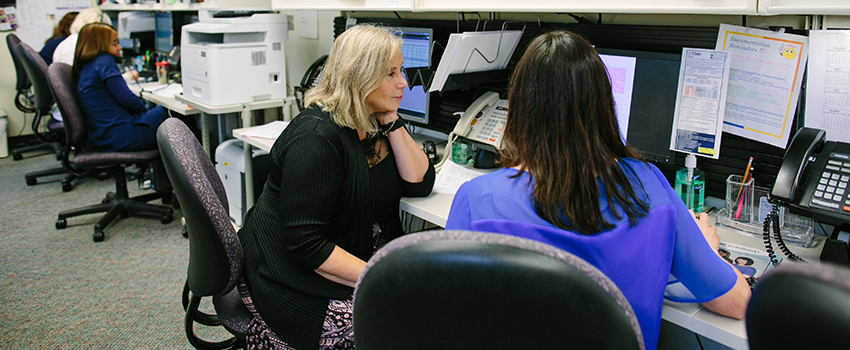
Photo credit: Leisa Thompson and Erica Bass
In mid-March 2020, the orders came to shut everything down.
With COVID-19 rampaging throughout the world, researchers across the University of Michigan were forced to power off their labs. Enrollment in clinical trials paused. In-person clinics were canceled unless there was an emergency.
The health care workers and scientists at the University of Michigan Rogel Cancer Center immediately understood the need for these restrictions. And as time wore on, it became clear that these disruptions were not going to be short lived.
“We thought at first we would be out for maybe two weeks, that we would send everybody home and regroup,” says Mathew Innes, director of the Oncology Clinical Trials Support Unit at Rogel. “Then we just kept staying and staying and staying.”
But as the pandemic continued to evolve, the work never really stopped. Rogel staff and members needed to figure out ways to innovate their research, collaborate to meet patient needs and be efficient despite the uncertainty swirling around them.
Here’s what they did.
‘Just revolutionary’
When the order came to restrict in-person clinic visits, emails were flying with ideas about what to do.
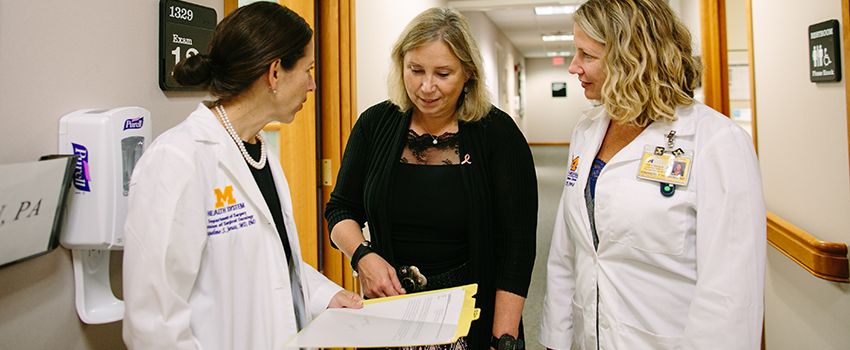
Photo credit: Leisa Thompson and Erica Bass
Sofia Merajver, M.D., Ph.D., director of the Breast and Ovarian Cancer Risk Evaluation Program at Rogel, remembers turning to her team of three genetic counselors and one scheduler. “I felt a certain sense of going to battle,” she says. “There was a problem in front of us, and we had to meet it.”
She told her team, “We are going to have a full clinic on Monday. We’re going to see everyone by telephone or video. We’ll document everything we do the usual way and worry about who pays for what later. We won’t cancel a single patient.”
And they didn’t.
“I'm a researcher, so I suppose you could define me as somebody who lives by her wits,” Merajver says. “There was this idea of bringing forth our problem-solving ability, which is how we make a living as scientists, right?”
To pull this off, Merajver’s team organized what she calls a clinical conference. Her genetic counselors created a PowerPoint that featured a “nutshell of information” about every patient the team would see the following Monday.
Each Friday, they’d go over the presentation and over the weekend, Merajver would memorize the details of anywhere between 17 and 20 patients.
Merajver says she’s always tried to learn everything she can about a patient before their appointment, as she was taught during her training at the University of Michigan Medical School. But committing more than a dozen patient biographies to memory at one time was a new test for her recall.
“I’m not an actress, you know,” Merajver says. “I’m not used to memorizing the whole of Macbeth. But I challenged myself to learn a radically new way of getting to know patients.”
On Mondays, Merajver and her team would see new patients by phone or video every half hour from 8 a.m. to 4 p.m., without any breaks to go to the staff room and debrief.
Despite this pace, Merajver says, her team found they often did a better job serving patients with telehealth.
“Seeing patients faster, seeing relatives of patients that we are certain have a gene mutation, seeing a lot more patients from remote locations, a lot of patients who are transportation-challenged. It’s been just revolutionary for us.
“And you know what?” she continued “The way we did it at the beginning, with this conference, is the way we still do it now. Three years later, we are doing exactly the same thing.”
Exploring the data
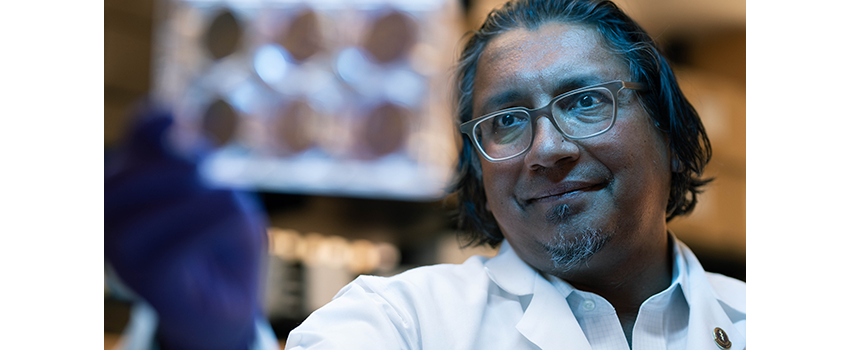
Photo credit: Leisa Thompson and Erica Bass
As the pandemic unfolded, Goutham Narla, M.D., Ph.D., and his team were glued to the news.
The restrictions issued on biomedical research meant that Narla, a Rogel researcher studying how to activate faulty tumor suppressor proteins, needed to limit most of his lab’s activities immediately.
All the cell-based assays stopped. Narla and his graduate students and postdocs froze the unique cell lines they’d generated. Fortunately, there weren’t any ongoing animal studies that required multiple dosings, but the team had to go into emergency colony maintenance to keep their transgenic strains alive and well.
“At first, it was a major adjustment,” Narla says. “We went from going at 100 miles per hour to zero.”
Suddenly, Narla and his team found they had a lot more time on their hands. Amid virtual journal clubs and happy hours, they began thinking about what normally would fall to the bottom of their to-do lists, like reading more research literature and revisiting old data that could now be analyzed in new ways.
Once the team started digging into the past, they found possibilities for the future. For instance, a series of mutations in the amino acid Narla studied turned out to be different than what they’d originally categorized. These different mutations occurred in very specific tumor types, so the team hypothesized that they would point to different tumor biology, which has turned out to be the case.
Plus, they discovered that some small molecules they thought were inactive actually turned the tumor suppressor target off. These structurally similar molecules could allow them to confirm whether the drugs they would develop were specific enough.
“When you’re screening thousands of molecules, sometimes you don’t stop and assess the whole landscape,” Narla says. “We’re really able to do that now. With all of that information, we have a lead molecule that’s about a year away from clinical trials and drug development for the first time.”
Training for triage
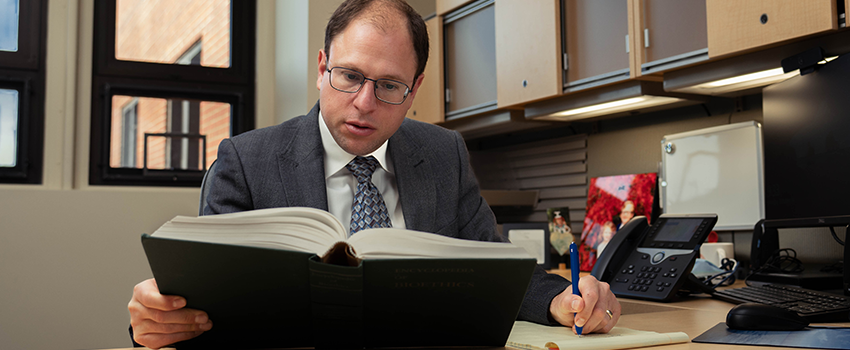
Photo credit: Leisa Thompson and Erica Bass
Andrew Shuman, M.D., had been planning for this type of crisis for a long time.
The associate professor of otolaryngology and Rogel member is also an internationally recognized bioethicist, dealing in philosophical questions about when, how and in what order to provide health care and facilitate biomedical research.
“Especially in the world of cancer, where many of these health issues are urgent but not necessarily emergent,” Shuman says, “it’s quite complicated to think about how we can equitably and fairly, but also responsively, triage many aspects of care in a way that’s informed by good data and sound ethics and practice.”
As the co-chair of the Scarce Resources Allocation Committee at Michigan Medicine, Shuman was thrust into the spotlight at the beginning of the pandemic as he sought to create a framework that guided his peers in deciding which of their patients, including those who were immunocompromised, still needed treatment during a high-risk period.
Luckily, he’d been trained in an environment with a long history of crisis triage expertise. Bioethicists from the University of Michigan had developed an outline for how to allocate ventilators during the swine flu pandemic of 2009 and 2010, which the Michigan Department of Community Health then adopted as part of its plan for distributing scarce medical resources and services during public health emergencies.
“U-M has been active in this research, advocacy and policy space for decades,” Shuman said. “Over the course of many years, we’ve developed our ability to work through these challenges — not anticipating COVID, obviously, but anticipating the need to deal with this issue during crisis.”
When Shuman and his co-chairs Marie Lozon, M.D., and Sandro Cinti, M.D., had to ramp up their scarce resource allocation strategy during the current pandemic, they created specific working groups to deal with issues ranging from limited ventilators, dialysis machines and ECMO circuits to how to coordinate cancer care.
Shuman and others shared that expertise outside of Michigan Medicine’s campus as well, partnering with 28 other head and neck surgeons from different health care systems to create a novel cancer-specific tool to help prioritize surgical cases in the COVID-19 era. Their paper about development and validation of the tool was published in the journal Cancer in August 2020.
“I’m very proud of the efforts we put forward,” Shuman said. “Being prepared and proactive is one of the things we excel at as an institution.”
Virtual community
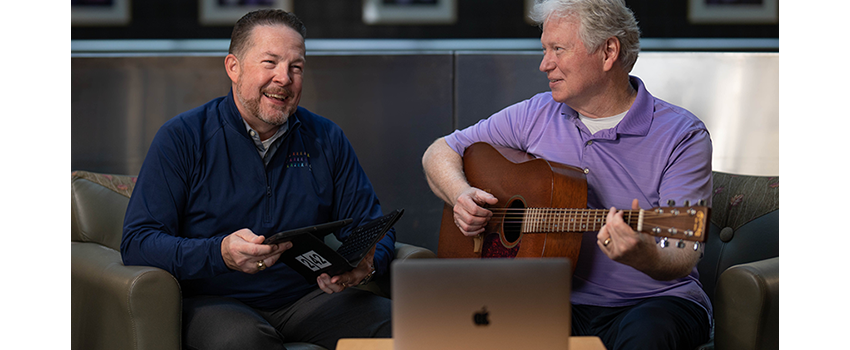
Photo credit: Leisa Thompson and Erica Bass
By the beginning of 2022, Rogel’s Patient and Family Support Services team — a group of art and music therapists, social workers, chaplains and child-life specialists — had figured out how to meet patients where they were. They moved many of their offerings online and were hearing — and seeing — the benefits.
Missed appointments dried up. Patients who lived further away suddenly had more options to attend programs. They were more relaxed because they didn’t have to deal with the mental and physical exhaustion of 14 other appointments — and even if they were feeling awful, they could put up an avatar on their Zoom and still participate.
Noting how virtual programming allowed patients to show up more, and more easily — and that patients often loved it — the PFSS team created a new men’s support group.
On the second and fourth Mondays of the month, men being treated at Rogel can log into Zoom. Bruce Paul, one of the cancer center’s chaplains, starts by reading a virtue — things like understanding or dignity — and Bob Huffman, the music therapist at Rogel, plays calming music. The ground rules: confidentiality, respect, letting everyone speak so no one monopolized time. And, of course, no women allowed.
The virtual format created a sense of community for men ranging from their early 20s to mid-60s who lived hours apart. The only denominator that mattered was cancer.
“Once it got rolling, the candidness and the comfort level was great,” Huffman says.
The group discussed different topics like resiliency and legacy. They shared their fears of running out of treatment options and how lonely they often felt. People with cancers in male parts (prostate, testicular) touched on the side effects from surgeries that had led to incontinence or intimacy issues.
“I don’t think these guys would have come into an office or a room to do this,” Paul says. “One of the blessings I’ve found from the pandemic is that we started these new technologies out of necessity, but we’ve kept it going.”
‘We can do this’
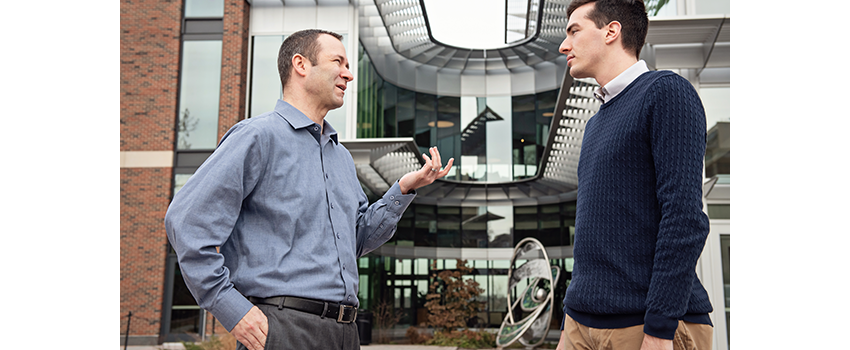
Photo credit: Leisa Thompson and Erica Bass
The word spread on social media about a group forming, a consortium of cancer centers that would band together to share data and best practices around COVID-19 and how it affected their high-risk patients.
Christopher Friese, Ph.D., R.N., Rogel’s associate director for cancer control and population sciences, heard about the group from a colleague at Vanderbilt-Ingram Cancer Center who had built a registry to detail how cancer patients responded to COVID-19 and was looking to include as many institutions as possible.
Friese felt Rogel could add value to this community — if they got the right people involved. His own background in health services and quality would be helpful, but he needed a medical oncologist on board, too.
Leslie Fecher, M.D., had already reached out to Anne Schott, M.D., the associate director for clinical research at the cancer center, about studying the experience of patients at Rogel with COVID-19.
She and Friese partnered with Rogel’s cancer registry, which has been collecting data on patients with cancer diagnosed or treated at Rogel since 1995. Together, they asked the institutional review board to accelerate the approval process for using this type of data.
“It really was a team approach,” Friese said. “We involved a lot of partnerships to make this happen relatively quickly and nimbly.”
The same could be said for the COVID-19 & Cancer Consortium as a whole. Just seven months after the consortium formed, it published a paper using data the group had gathered — an unprecedented turnaround in the research space.
Thirteen more papers have come out of the consortium since, appearing in prestigious journals including The Lancet, Cancer Cell and various JAMA publications, and covering a range of crucial topics such as geriatric risk factors for serious COVID-19 outcomes among older adults with cancer and racial disparities and regional variability in COVID-19 outcomes among patients with cancer.
“It shows you that with a little bit of elbow grease, people thinking creatively and this sense of urgency, we are able to break through a lot of the traditional barriers,” Friese says.
“We can already see there’s great potential for this beyond COVID-19. It’s catalyzed a new approach of rapid cycle research. Now that we’ve developed the platforms, we know we can do this.”
Continuing trials
In the Oncology Clinical Trials Support Unit (O-CTSU), all didn’t stop at the start of the pandemic.
Although the unit paused enrollments for new clinical trials during the first four months of the pandemic, existing trials with a potential therapeutic benefit kept going. But the group needed to figure out how to make the trial logistics possible when their on-site presence was extremely limited.
Like so much else during the pandemic, the answer lay with pivoting to virtual, creating consent forms that could be signed online and conducting study visits remotely when possible.
“Most patients were doing virtual visits. Very few were coming in person,” says Sujata Guduri, administrative manager for the O-CTSU’s clinic research group operations.
Yet one crucial element of clinical trials was a lot more complicated to do asynchronously: getting drugs to patients.
Michigan Medicine’s research pharmacy already had some experience shipping medications on a limited basis, but now they needed to scale up — and cut through all kinds of red tape.
If a study medication was considered an investigational new drug, federal laws allowed for it to be shipped across state lines without restriction. Otherwise, Michigan Medicine needed to be cognizant of mail order pharmacy regulations regarding shipping to other states. Plus, the pharmacy needed permission from the study’s principal investigator and the study sponsor.
If everyone signed off, the pharmacy then needed to ensure the drug arrived within the required timeframe and that the correct temperature conditions were maintained throughout shipping. When the pharmacy first decided to ship drugs, one of their most significant tasks was finding a vendor who could provide enough temperature-regulating shipping containers to mail the medications.
Finally, the drugs needed to come with the appropriate documents typically provided during in-person visits. This included things like a drug diary where patients recorded how much of a drug they took and at what time, or other instructions on how to take the drug correctly.
Once the logistics were figured out and sponsors got on board, the team created workflows that allowed study teams to make formal drug shipping requests.
Over time, study teams, sponsors and patients got used to the shift, and Kim Redic, Pharm.D., assistant director of the Research Pharmacy, says her team continues to ship more clinical trial drugs than they did pre-pandemic. She notes, however, that because of the added cost and complexity of ensuring that drugs arrive on time and in usable condition, it should happen only in specific situations in which patients are not able to receive the study medications in person.
But in those early months, when everything about the way patients accessed medicine had to be rethought, Redic says the teams understood the immense need to be flexible and to do things differently.
“We had an unquestioned lean-in,” Redic says. “We knew this was what we had to do in the interest of our efforts locally for our patients but also for the greater needs of society. People didn’t question or complain. They just did.”
Continue reading Illuminate, 2023 or download the print version.
